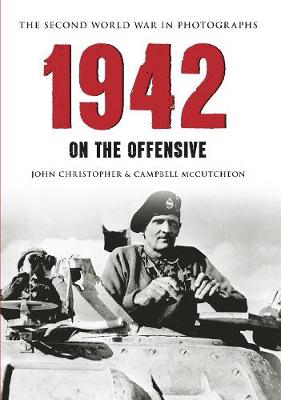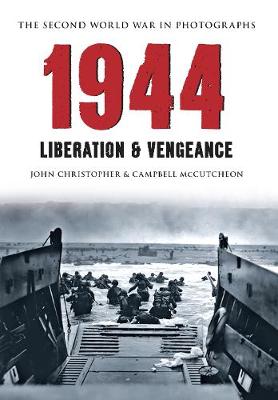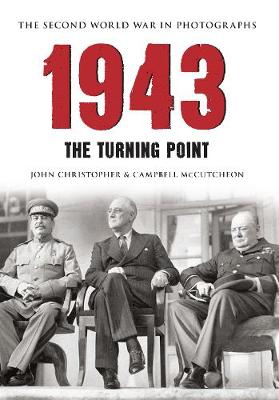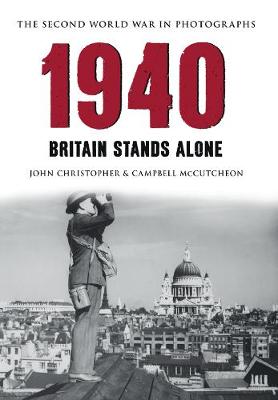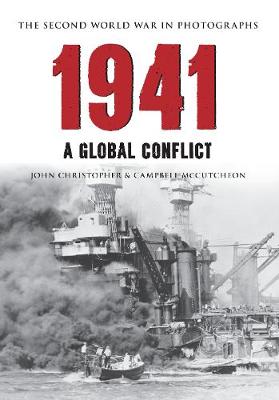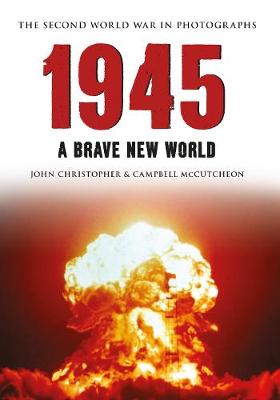The Second World War in Photographs
7 total works
1942 The Second World War in Photographs
by John Christopher and Campbell McCutcheon
Published 15 February 2015
1942 was the turning point of the war. In the words of Winston Churchill, it was 'not the end. It is not even the beginning of the end, but it is, perhaps, the end of the beginning.'
In the Pacific the Japanese had been soundly defeated at the Battle of Midway, with the loss of four valuable and irreplaceable aircraft carriers, while the Allied landings in North Africa had been a complete success, and the rout of the German and Italian soldiers in the desert war had begun in earnest. Fortress Britain saw the infamous Baedeker raids on English towns and cities, but also the build-up of American troops and material in preparation for the invasion of mainland Europe, of which August's costly raid on Dieppe was a precursor. Despite some setbacks, the war had changed and the Allies were on the attack on all fronts. In Russia, the German 6th Army spent the New Year surrounded in Stalingrad, the Germans and Italians being squeezed in North Africa, and the Japanese were suffering defeat after defeat.
John Christopher and Campbell McCutcheon tell the story of 1942 at war using many rare and often unpublished images, showing the rapidly changing nature of the conflict, as well as its impact on the everyday person.
In the Pacific the Japanese had been soundly defeated at the Battle of Midway, with the loss of four valuable and irreplaceable aircraft carriers, while the Allied landings in North Africa had been a complete success, and the rout of the German and Italian soldiers in the desert war had begun in earnest. Fortress Britain saw the infamous Baedeker raids on English towns and cities, but also the build-up of American troops and material in preparation for the invasion of mainland Europe, of which August's costly raid on Dieppe was a precursor. Despite some setbacks, the war had changed and the Allies were on the attack on all fronts. In Russia, the German 6th Army spent the New Year surrounded in Stalingrad, the Germans and Italians being squeezed in North Africa, and the Japanese were suffering defeat after defeat.
John Christopher and Campbell McCutcheon tell the story of 1942 at war using many rare and often unpublished images, showing the rapidly changing nature of the conflict, as well as its impact on the everyday person.
1944 The Second World War in Photographs
by John Christopher and Campbell McCutcheon
Published 15 May 2015
1944 saw the largest seaborne invasion ever staged in Operation Overlord. The Allied landings on the beaches of Normandy on D-Day, 6 June 1944, opened the way for the thrust into the occupied countries of northern Europe, in particular France, with the Allies liberating Paris in August. This was the first major milestone in the eastwards drive into the heart of Germany.
Other triumphs in the sixth year of the war included the Red Army regaining Leningrad on the Eastern Front, defeats for the Japanese in the Battle of the Philippine Sea as well as the British advances in Burma, and there were the American landings in Anzio, the taking of Rome, and further landings in Greece. Victory was almost within sight, but it couldn't be taken for granted as the war was entering a new phase and the Nazi war machine still had a sting in its tail. Infuriated by Allied gains, Hitler unleashed the long-promised Vengeance weapons, in particular the V1 flying bomb and the V2 ballistic missile, in the belief that they would turn the tide of the war in Germany's favour. There was also the question of whether Nazi scientists were developing an atomic bomb.
John Christopher and Campbell McCutcheon tell the story of 1944 at war using many rare and often unpublished images, showing the rapidly changing nature of the conflict.
Other triumphs in the sixth year of the war included the Red Army regaining Leningrad on the Eastern Front, defeats for the Japanese in the Battle of the Philippine Sea as well as the British advances in Burma, and there were the American landings in Anzio, the taking of Rome, and further landings in Greece. Victory was almost within sight, but it couldn't be taken for granted as the war was entering a new phase and the Nazi war machine still had a sting in its tail. Infuriated by Allied gains, Hitler unleashed the long-promised Vengeance weapons, in particular the V1 flying bomb and the V2 ballistic missile, in the belief that they would turn the tide of the war in Germany's favour. There was also the question of whether Nazi scientists were developing an atomic bomb.
John Christopher and Campbell McCutcheon tell the story of 1944 at war using many rare and often unpublished images, showing the rapidly changing nature of the conflict.
1939 the Second World War in Photographs
by John Christopher and Campbell McCutcheon
Published 15 August 2014
Seventy-five years ago, on 1 September 1939, Germany invaded Poland. With political agreements in place to come to Poland's aid, Britain and France both declared war on Germany within two days. It was the start of a conflict that would erupt over every continent and see the deaths of tens of millions of people, with much of central Europe destroyed. It would also see the development of jets, intercontinental missiles, computers and the Atomic Bomb.
1939, in particular, saw the sinking of the passenger ship Athenia on the first day of the war, the evacuation of children from Britain's population centres, the daring attack by U-49 on the Royal Oak at Scapa Flow, air raids on Wilhelmshaven and on Shetland and the Forth Bridge. It also saw the development of the Blitzkrieg tactics that were to prove so successful in France, Belgium and the Netherlands in 1940.
1939, in particular, saw the sinking of the passenger ship Athenia on the first day of the war, the evacuation of children from Britain's population centres, the daring attack by U-49 on the Royal Oak at Scapa Flow, air raids on Wilhelmshaven and on Shetland and the Forth Bridge. It also saw the development of the Blitzkrieg tactics that were to prove so successful in France, Belgium and the Netherlands in 1940.
1943 The Second World War in Photographs
by John Christopher and Campbell McCutcheon
Published 15 April 2015
1943 saw the Allies on the offensive, with victories in North Africa followed by the invasion of Sicily and landings in Italy establishing a foothold on mainland Europe, while on the Eastern Front the Red Army was making gains, and in the Pacific the Japanese-held islands were falling.
The change in the Allies' fortunes had begun the previous year and now they were building on those successes, paving the way for the major return to Europe with D-Day planned for 1944. The 8th Army's successes in the Tunisian campaign pushed the German Afrika Korps out of North Africa. This was followed by the invasion of Sicily in May and landings on the toe of Italy in September, resulting in the ousting of Benito Mussolini. Other Allied successes came in the Pacific with the taking of Papua New Guinea and the Solomon Islands, together with British and Chinese advances in Burma, putting the Japanese onto the defensive. The conflict in Russia saw the key tank battle at Kursk and the subsequent retaking of some German-held territory. Other events included the Dambuster raids, an attack on the Ploesti oil refineries and the uprising in the Warsaw Ghetto.
John Christopher and Campbell McCutcheon tell the story of 1943 at war using many rare and often unpublished images, showing the rapidly changing nature of the conflict.
The change in the Allies' fortunes had begun the previous year and now they were building on those successes, paving the way for the major return to Europe with D-Day planned for 1944. The 8th Army's successes in the Tunisian campaign pushed the German Afrika Korps out of North Africa. This was followed by the invasion of Sicily in May and landings on the toe of Italy in September, resulting in the ousting of Benito Mussolini. Other Allied successes came in the Pacific with the taking of Papua New Guinea and the Solomon Islands, together with British and Chinese advances in Burma, putting the Japanese onto the defensive. The conflict in Russia saw the key tank battle at Kursk and the subsequent retaking of some German-held territory. Other events included the Dambuster raids, an attack on the Ploesti oil refineries and the uprising in the Warsaw Ghetto.
John Christopher and Campbell McCutcheon tell the story of 1943 at war using many rare and often unpublished images, showing the rapidly changing nature of the conflict.
1940 the Second World War in Photographs
by John Christopher and Campbell McCutcheon
Published 15 September 2014
1940 As the period of the 'Phoney War' came to an end, the Nazis unleashed their Blitzkrieg tactics, which saw the rapid mobility of the ground forces closely supported by superior air power. The Netherlands, Belgium, Denmark and Norway fell in the spring, and the British Expeditionary Force made a hasty retreat from the beaches of Dunkirk in Operation Dynamo. Winston Churchill, the new Prime Minister of the coalition government, described the evacuation of thousands of troops by an armada of little vessels as a miracle. But, following the fall of France in June, he issued a sombre warning that Britain now fought alone. The nation's fate was in the hands of the 'Few', the men of fighter command who fought to hold back Goering's Luftwaffe in its bid to gain superiority in the air as the prelude to a German invasion. This was the Battle of Britain, and as the Spitfires and Hurricanes jousted with enemy fighters and bombers in the late summer of 1940, the ordinary people of London and many other cities and towns came to know the terror of the air raids.
John Christopher and Campbell McCutcheon tell the story of 1940 at war using many rare and often unpublished images, showing the rapidly changing nature of the conflict, as well as its impact on the everyday person.
John Christopher and Campbell McCutcheon tell the story of 1940 at war using many rare and often unpublished images, showing the rapidly changing nature of the conflict, as well as its impact on the everyday person.
1941 The Second World War in Photographs
by John Christopher and Campbell McCutcheon
Published 15 November 2014
1941 At the beginning of the year, Britain stood alone against Germany and Italy. The war in Africa dominated the headlines, with huge swathes of the North African desert changing hands continually. At sea, Germany's Bismarck sank HMS Hood, but was soon sunk herself, while Fortress Britain endured night after night of heavy Blitz and the horrors of the Luftwaffe's incendiary bombs. The first turning point of the war came in June, with Operation Barbarossa - Germany's invasion of the Soviet Union - opening up a second front in the east. The next would not come till December, when the war moved from beyond its European and African front lines to become a truly global conflict. Japan awoke the sleeping giant that was the USA with a surprise attack on Pearl Harbor. Simultaneous attacks on Hong Kong, Malaya, the Philippines and Indonesia saw huge parts of Asia firmly under Japanese control by the end of the year.
John Christopher and Campbell McCutcheon tell the story of 1941 at war using many rare and often unpublished images, showing the rapidly changing nature of the conflict, as well as its impact on the everyday person.
John Christopher and Campbell McCutcheon tell the story of 1941 at war using many rare and often unpublished images, showing the rapidly changing nature of the conflict, as well as its impact on the everyday person.
1945 The Second World War in Photographs
by John Christopher and Campbell McCutcheon
Published 15 June 2015
1945 was the meeting point of two eras. It marked the end of the Second World War, a conflict ushered in by the lightning strikes of the Blitzkrieg and characterised by the brutalities inflicted by the Nazi regime. It concluded with the dropping of atomic bombs on the Japanese cities of Hiroshima and Nagasaki - events that shaped the course of post-war history.
After six long years of war, the Allies' inexorable push into the heart of Germany brought the conflict in Europe to an end in the spring, but not without incident. The fire-bombing of Dresden in February destroyed a city and killed an estimated 130,000, and the final days of Hitler's Reich saw bitter battles in the streets of Berlin. It was only once the fighting was over that the world became aware of the horrors of the concentration camps and the systematic attempt by the Nazis to wipe out an entire section of the human race. In the Pacific the fighting continued into the summer until the Allies, faced with a prolonged campaign to take each and every island stronghold, dropped the A-bombs on Hiroshima and Nagasaki, bringing the war to a sudden end in August 1945. Yet even before the dust had settled, the victorious nations were carving up the conquered territories to create a new world order in which the Cold War era saw former Allies turned into enemies.
John Christopher and Campbell McCutcheon tell the story of 1945 at war using many rare and often unpublished images, showing the conclusion of the conflict and the dawn of the Cold War.
After six long years of war, the Allies' inexorable push into the heart of Germany brought the conflict in Europe to an end in the spring, but not without incident. The fire-bombing of Dresden in February destroyed a city and killed an estimated 130,000, and the final days of Hitler's Reich saw bitter battles in the streets of Berlin. It was only once the fighting was over that the world became aware of the horrors of the concentration camps and the systematic attempt by the Nazis to wipe out an entire section of the human race. In the Pacific the fighting continued into the summer until the Allies, faced with a prolonged campaign to take each and every island stronghold, dropped the A-bombs on Hiroshima and Nagasaki, bringing the war to a sudden end in August 1945. Yet even before the dust had settled, the victorious nations were carving up the conquered territories to create a new world order in which the Cold War era saw former Allies turned into enemies.
John Christopher and Campbell McCutcheon tell the story of 1945 at war using many rare and often unpublished images, showing the conclusion of the conflict and the dawn of the Cold War.
